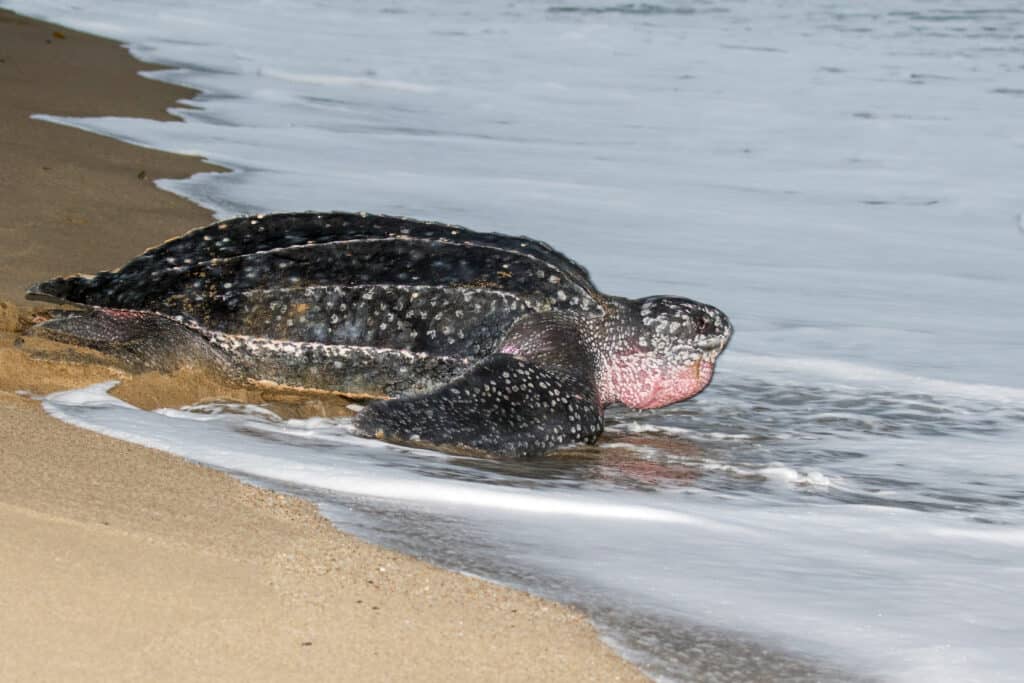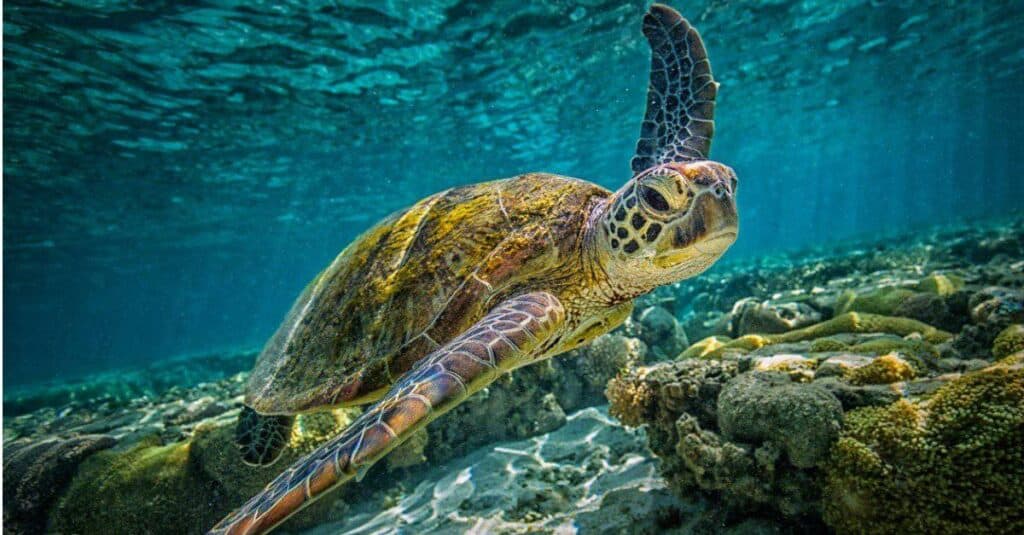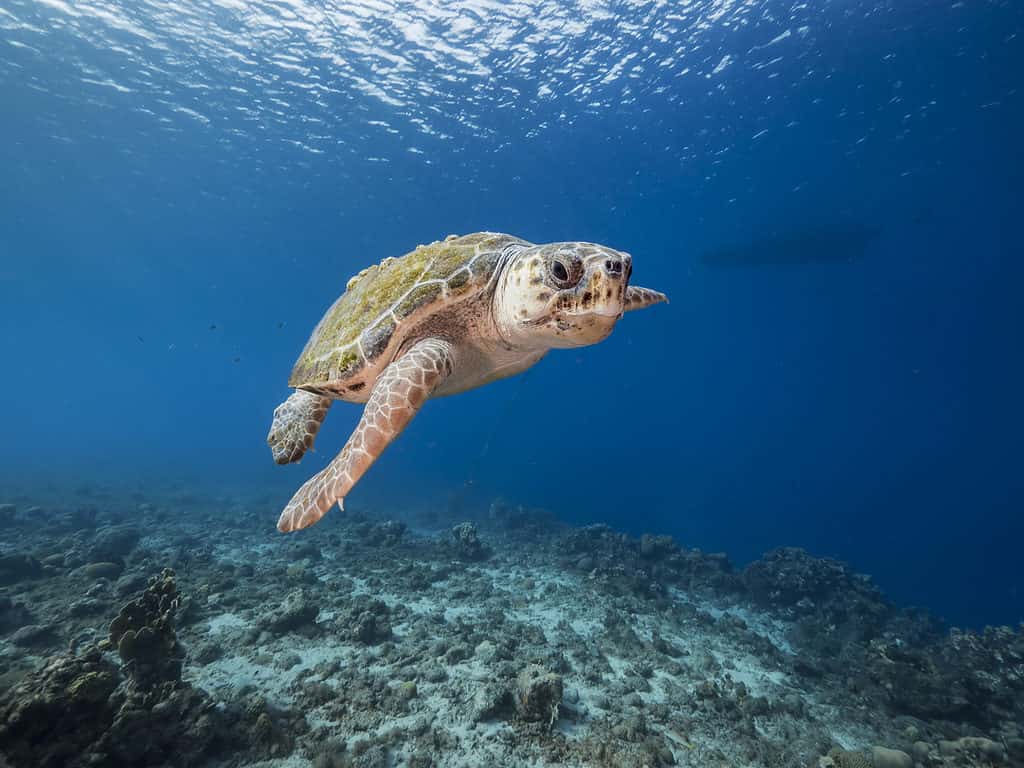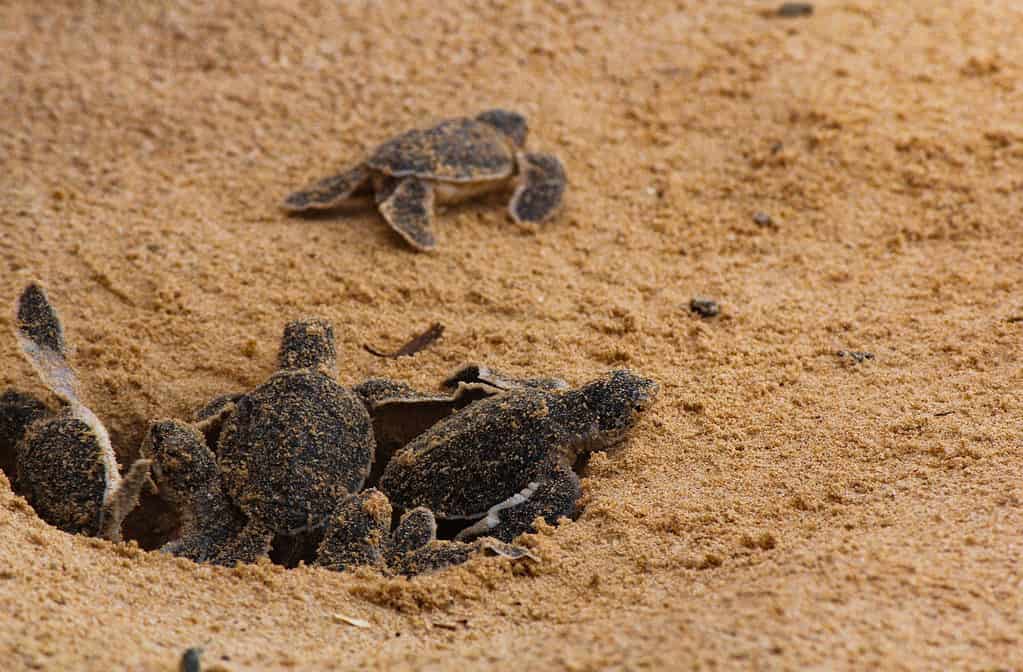Leatherback sea turtles are the largest sea turtles in the world. These turtles can weigh up to 2,000 pounds! They get their name from their unique shell. Most sea turtles have a hard, outer shell. The leatherback sea turtle’s shell is different. Their shell is made up of thin, rubber-like skin. Many small bone plates are under that layer of skin. The bone plates and thin skin combined are what give the leatherback sea turtle’s shell its leather-like appearance.
This article focuses on the leatherback sea turtle’s size. It offers size comparisons, information on the largest leatherback sea turtle, and a variety of fun facts about this incredible animal.
Leatherback Sea Turtles and Their Size

Adult female leatherback sea turtles leave the water to nest. They will nest four to seven times per season.
©iStock.com/AGAMI stock
Leatherback sea turtles (Dermochelys coriacea) are the largest of all seven types of sea turtles. These sea turtles weigh between 500 pounds to over one ton! While they are the largest sea turtle by far, they are not the easiest to study. They are very difficult to study because they are solitary animals and are often found in ocean waters that are too deep for human divers. Leatherback sea turtles can dive up to depths of 4,000 feet. These turtles possess some ability to regulate their own body temperature, making it possible for them to withstand the cold temperatures of the sea depths.
Leatherback Sea Turtle vs. Green Sea Turtle Size Comparison

Green sea turtles average about 150-419 pounds, with a maximum of 871 pounds.
©iStock.com/Greg Sullavan
Green sea turtles (Chelonia mydas) are often what come to mind when people imagine sea turtles. They are one of the most recognized sea turtles out of the seven types. Although green sea turtles are significantly smaller than leatherback sea turtles, they are the third largest sea turtles out of the seven species.
Leatherback sea turtles can reach up to 1,550 pounds, while green sea turtles usually max out around 400 pounds. The shell of a green sea turtle averages around 5 feet long. The shell of a leatherback sea turtle is usually closer to 7 feet long.
Apart from their size difference, you can also tell them apart by their shells. Green sea turtles have patterned shells of brown, black, or yellow. Leatherback Sea Turtles have dark gray, leather-like shells.
Leatherback Sea Turtle vs. Loggerhead Sea Turtle Size Comparison

Loggerheads are the largest hard-shelled turtle. They are second only to the leatherback sea turtle for the largest turtle in the world.
©iStock.com/naturepics_li
Loggerhead sea turtles (Caretta caretta) are the next largest sea turtles after leatherback sea turtles. Although closest in size to the Leatherback, the loggerhead most closely resembles the green sea turtle in physical appearance. You can tell the difference between the two by their head size. Loggerhead sea turtles have larger heads in proportion to their bodies.
Although these turtles are the largest of the hard-shell turtles, they are no match for the size of the leatherbacks. They average around 289 pounds, but they have been recorded to reach a maximum of 1,200 pounds. It is common to find a leatherback sea turtle that is between 600-1,600 pounds.
While the leatherback sea turtles are already considered endangered, the loggerhead sea turtles are not far behind. They are currently considered in a vulnerable state. Humans play a huge role in their current status.
Leatherback Sea Turtle vs. Other Sea Turtles
There are four remaining types of sea turtles in addition to the leatherback, green, and loggerhead sea turtles. All of these sea turtles are significantly smaller than the leatherback, but have their own distinguishing characteristics. In this section, we will showcase the difference in size and share basic information about each type of sea turtle.
Leatherback Sea Turtle vs. Hawksbill Sea Turtle
Hawksbill sea turtles (Eretmochelys imbricata) are one of the smaller sea turtle types. They typically range between 100-200 pounds and their shells only reach around 3 feet in length. These turtles have a more specific diet than most, feeding almost exclusively on sponges. This differs greatly from the leatherback’s 600 pounds and diet of jellyfish and sea squirts.
Leatherback Sea Turtle vs. Kemp’s Ridley Sea Turtle
Kemp’s ridley sea turtle (Lepidochelys kempii) is the smallest of all the sea turtle types. Only reaching between 75-100 pounds and 2 feet in length. While their size may differ greatly, their conservation status does not. Various human activities have threatened this sea turtle’s conservation status just as it has with the leatherback sea turtle. Luckily, due to strict protection laws, their population is slowly on the rise.
Leatherback Sea Turtle vs. Olive Ridley Sea Turtle
Olive ridley sea turtles (Lepidochelys olivacea) are also very small. They are very similar in size to the Kemp’s ridley sea turtle, but they are slightly longer. These sea turtles also range between 75-100 pounds, but their shells tend to be about 2.5 feet long. Olive ridley sea turtles nest in arribadas, and the females will nest one to three times a season. This differs from the leatherback sea turtles, who will return to nest every two to four years.
Leatherback Sea Turtle vs. Flatback Sea Turtle
Flatback sea turtles (Natator depressus) get their name from their shells, which lack the typical curve you would find on other sea turtle shells. These sea turtles average about 200 pounds and 3 feet in length. Due to their limited distribution, these sea turtles are the least studied of all sea turtle types. They can only be found near Northern Australia, Southern Indonesia, and Southern Papua New Guinea. Leatherback sea turtles can be found more readily, across the Atlantic, Pacific, and Indian oceans.
Leatherback Sea Turtle vs. Whitetip Reef Shark Size Comparison

Small and docile, these sharks don’t usually reach lengths past 5 feet.
©Rich Carey/Shutterstock.com
Sharks are often what come to mind when people think of the largest sea animals. The leatherback sea turtle’s size may not compare to that of a whale shark or a great white shark, but it does compare to other shark species. One example is the whitetip reef shark. Usually dwelling in the shallow waters near coral reefs, this shark is very similar in size to the leatherback sea turtle.
They can grow up to 7 feet, but the average length of a whitetip reef shark is around 5 feet. This is smaller than the average leatherback sea turtle size of 7 feet. The shark’s maximum average weight is around 40 pounds, whereas the leatherback sea turtle’s is over 500 pounds.
Are Leatherback Sea Turtles Bigger Than Any Other Sharks?
Some of the more well-known sharks, such as great whites, bull sharks, tiger sharks, and whale sharks are much bigger than the leatherback. Below is a chart that shows the difference in their sizes.
| Type of Shark vs. Leatherback | Average Size |
|---|---|
| Pygmy Shark | 8.6-11 inches |
| Leatherback Sea Turtle | 7-8 feet |
| Bull Shark | 7-11.5 feet |
| Tiger Shark | 10-14 feet |
| Great White Shark | 18-26 feet |
| Whale Shark | 40 plus feet |
Leatherback Sea Turtle vs.Volkswagen Beetle Type 1 Size Comparison
The Volkswagen Beetle Type 1, or the Beetle as many people know it, is a very popular car. To demonstrate the large size of the leatherback sea turtle, the length of the Volkswagen Beetle Type 1 car is just over 13 feet. Coming in at 7 feet, the leatherback sea turtle is more than half of that length! So, the next time you see a VW Beetle driving down the road, know that it is the size of about one and a half leatherback sea turtles!
The Largest Leatherback Sea Turtle Ever Recorded
Leatherback sea turtles are not only the largest among the sea turtles but they also rival turtles on land as well. The Galapagos tortoise is the largest land tortoise in the world, and the leatherback sea turtle is still larger than it! The Galapagos tortoise averages around 575 pounds. The largest leatherback sea turtle ever recorded weighed in at 2,120 pounds. It measured 9 feet and 5.5 inches long. With the average person in America being around 5 feet 5 inches tall, it is easy to see how large this leatherback sea turtle really was.
How Big Are Leatherback Sea Turtles When They Are Born?

The journey from nest to open ocean is one of the most dangerous times in a baby sea turtle’s life. Often, seagulls will swoop down and grab the turtles before they make it to the open waters.
©SLSK Photography/Shutterstock.com
Leatherback sea turtles don’t start out as massive 1,000-pound creatures. When they are baby sea turtles, or hatchlings, they are only about 3 inches long. These hatchlings emerge about 60 days after the mother makes her nest, and they make their way back to the ocean. The journey across the sand and into the water is dangerous for the hatchlings. Many birds prey on these turtles as they scurry across the beach. They don’t receive any help in the ocean either. It is up to the hatchlings to make it to the nursery habitats all on their own to avoid the dangerous predators lurking in the ocean.
Where Do Leatherback Sea Turtles Live?
The leatherback sea turtle can be found all over the world. Their territory ranges from land, during nesting season, to ocean depths of up to 4,000 feet. They are often found in temperate ocean waters and can be located in the Atlantic, Pacific, and Indian oceans. Leatherbacks are found from Alaska, down to Africa. Although widespread, their nesting usually occurs in more tropical regions. In the United States, their nesting most often occurs in Florida, Puerto Rico, and the U.S. Virgin Islands.
Are Leatherback Sea Turtles Endangered?
The leatherback sea turtle has different conservation statuses depending on its location in the world. In the United States, they were listed as endangered in 1970 and have remained that way ever since.
Internationally, they were deemed vulnerable in 2013.
Are Leatherback Sea Turtles Omnivores?
Leatherback sea turtles are gelatinivores. Their mouths and throats are specially designed to consume gelatinous prey that other species would have difficulty with. Their mouths and throats contain backward-facing spines that aid them in trapping that prey. Due to the leatherbacks’ specialized jaws, it is difficult for them to consume harder prey. For this reason, jellyfish and sea squirts are the leatherback sea turtle’s main prey.
The photo featured at the top of this post is © Stephanie Rousseau/Shutterstock.com
Thank you for reading! Have some feedback for us? Contact the AZ Animals editorial team.






